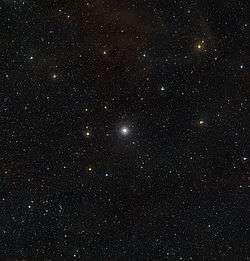17 Leporis
17 Leporis is a binary star system in the southern constellation of Lepus.[8] It has an overall apparent visual magnitude which varies between 4.82 and 5.06,[2] making it luminous enough to be visible to the naked eye as a faint star. The variable star designation for this system is SS Leporis, while 17 Leporis is the Flamsteed designation. Parallax measurements yield a distance estimate of around 730 light years from the Sun. The system is moving further away from the Earth with a heliocentric radial velocity of +18.7 km/s.[5]
 Wide field around SS Leporis. The field of view is approximately 2.7 degrees. | |
| Observation data Epoch J2000.0 Equinox J2000.0 (ICRS) | |
|---|---|
| Constellation | Lepus |
| Right ascension | 06h 04m 59.12941s[1] |
| Declination | −16° 29′ 03.9687″[1] |
| Apparent magnitude (V) | 4.82 to 5.06 (combined)[2] |
| Characteristics | |
| Spectral type | A1V + M6III[3] |
| U−B color index | +0.12 (combined)[4] |
| B−V color index | +0.24 (combined)[4] |
| R−I color index | +0.52 (combined)[4] |
| Variable type | Z And[2] |
| Astrometry | |
| Radial velocity (Rv) | +18.74±0.10 (center of mass)[5] km/s |
| Proper motion (μ) | RA: −5.951[1] mas/yr Dec.: −3.709[1] mas/yr |
| Parallax (π) | 4.4987 ± 0.1730[1] mas |
| Distance | 730 ± 30 ly (222 ± 9 pc) |
| Orbit[5] | |
| Period (P) | 260.34±1.80 d |
| Semi-major axis (a) | 4.492±0.014 mas[3] |
| Eccentricity (e) | 0.005±0.003[3] |
| Inclination (i) | 143.7±0.5[3]° |
| Longitude of the node (Ω) | 162.2±0.7[3]° |
| Periastron epoch (T) | 2,448,528.78±0.37 HJD |
| Argument of periastron (ω) (secondary) | 203.7±0.4° |
| Semi-amplitude (K1) (primary) | 6.1±1.0 km/s |
| Semi-amplitude (K2) (secondary) | 21.32±0.21 km/s |
| Details[6] | |
| A | |
| Mass | 2.71±0.27[3] M☉ |
| Radius | 18 R☉ |
| Luminosity | 1,900 L☉ |
| Surface gravity (log g) | 2.0 cgs |
| Temperature | 9,000 K |
| M | |
| Mass | 1.30±0.33[3] M☉ |
| Radius | 66.7±3.3[3] R☉ |
| Luminosity | 1,200 L☉ |
| Surface gravity (log g) | 1.0 cgs |
| Temperature | 3,250 K |
| Other designations | |
| Database references | |
| SIMBAD | data |
This is a double-lined spectroscopic binary system with an orbital period of 260 days and an eccentricity of 0.024.[5] The spectrum reveals the pair to consist of an A-type main-sequence star with a stellar classification of A1 V, and a red giant with a class of M6III. The close pair form a symbiotic binary with ongoing mass transfer from the giant to the hotter component. The giant does not appear to be filling its Roche lobe, so the mass transfer is coming from stellar wind off the giant. The pair are surrounded by a shell and a dusty circumbinary disk, with the former obliterating the lines from the A-type star.[3]
References
- Brown, A. G. A.; et al. (Gaia collaboration) (August 2018). "Gaia Data Release 2: Summary of the contents and survey properties". Astronomy & Astrophysics. 616. A1. arXiv:1804.09365. Bibcode:2018A&A...616A...1G. doi:10.1051/0004-6361/201833051. Gaia DR2 record for this source at VizieR.
- "SS Lep, database entry". The combined table of GCVS Vols I-III and NL 67-78 with improved coordinates, General Catalogue of Variable Stars. Moscow, Russia: Sternberg Astronomical Institute. Retrieved September 9, 2009.
- Blind, N.; et al. (December 2011). "An incisive look at the symbiotic star SS Leporis. Milli-arcsecond imaging with PIONIER/VLTI". Astronomy & Astrophysics. 536: 11. arXiv:1112.1514. Bibcode:2011A&A...536A..55B. doi:10.1051/0004-6361/201118036. A55.
- Hoffleit, D.; Warren, Jr., W. H. "HR 2148 database entry, The Bright Star Catalogue" (5th Revised (Preliminary Version) ed.). CDS. Retrieved September 9, 2009.
- Welty, Alan D.; Wade, Richard A. (January 1995). "On the nature of 17 Leporis". The Astronomical Journal. 109 (1669): 326–331. Bibcode:1995AJ....109..326W. doi:10.1086/117276. Seet Table 2.
- Verhoelst, T.; van Aarle, E.; Acke, B. (August 2007). "§3.1, Direct diameter measurement of a star filling its Roche lobe. The semi-detached binary SS Leporis spatially resolved with VINCI/VLTI". Astronomy and Astrophysics. 470 (3): L21–L24. arXiv:0705.4410. Bibcode:2007A&A...470L..21V. doi:10.1051/0004-6361:20077840.
- "17 Lep". SIMBAD. Centre de données astronomiques de Strasbourg. Retrieved 2019-05-31.
- §1, Verhoelst, van Aarle, and Acke, 2007.